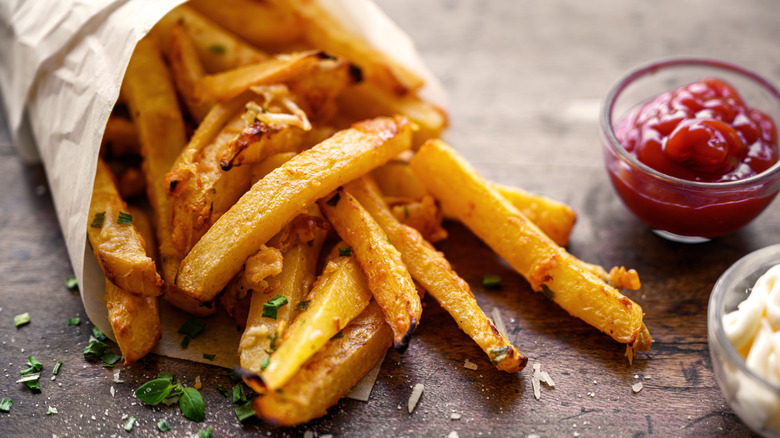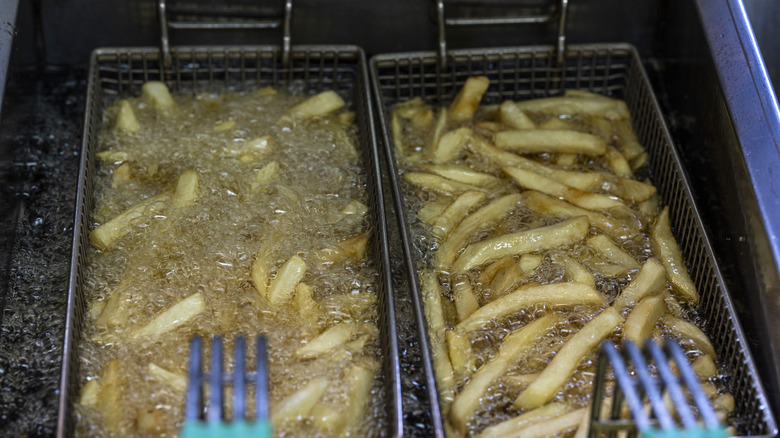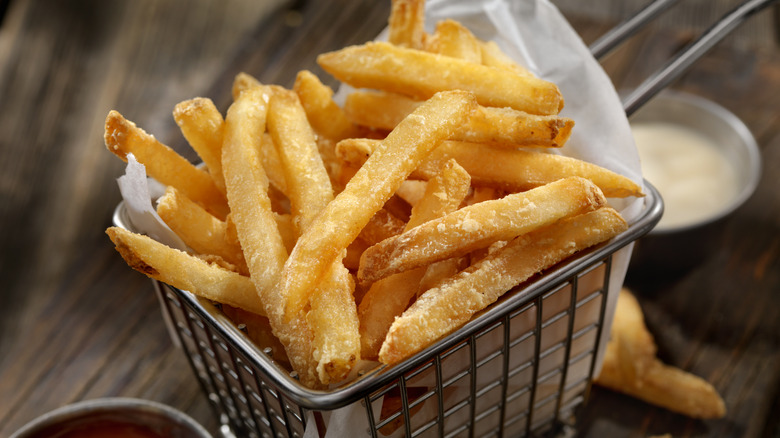The Reason French Fries Turn Golden Yellow When They're Cooked
Have you ever wondered why potatoes cooked in different ways yield not only different textures but also different colors? It might seem obvious that french fries will be golden brown when they're served. Boiled or baked potatoes, on the other hand, tend to retain their original pale or creamy white color, the same as they were before entering the oven or boiling water. But what accounts for this difference?
As it happens, the distinctive golden color of your french fries is the result of a scientific process called the Maillard reaction. Interestingly, this reaction is not exclusive to potatoes. It can occur in a range of foods, from meats you might be searing or grilling, to the baked goods you put in the oven. How various food items undergo this reaction differs, and the reasons behind these differences can be traced to the unique composition of each ingredient, along with the cooking time and temperature used. Not only that, but science explains that the aromatic and flavor compounds yielded from the Maillard reaction may be appealing to our tastes due to evolutionary predispositions.
A delicious science
The Maillard reaction takes place when food is exposed to heat, and during this event, the amino acids present in the potato's proteins interact with its natural sugars. This initiates a series of reactions akin to caramelization, which is when the sugars actually break down. When the Maillard reaction occurs, it not only gives potatoes the beautiful golden brown color that we find so appealing, but it also increases their flavor. In addition, the Maillard reaction actually makes foods easier to eat and digest, so there's belief in the scientific community that perhaps humans evolved to enjoy these flavors as a way to protect and nourish their body.
The way these flavor compounds unfold has to do with time and temperature. If you cook potatoes low and slow, you're less likely to see that caramelization, but if you cook them at a heat that's too high, then the outside will brown too much while the inside will remain raw. The key is to cook the potatoes at a high enough temperature to get them golden brown and crispy, while still allowing the inside enough time to come out soft and tender. If you're making oven fries, you want to bake them at 425 degrees Fahrenheit for 15 minutes before turning them. Then bake another 10 to 15 minutes until you get your desired color and texture. If you are frying in a pan or pot of oil, or using a deep fryer, follow your recipe carefully and make sure you have the proper equipment.
Sugar plays an important role
The crispiness of your french fries is influenced by other factors as well, including the sugar content of the potato and the specific potato variety you choose to use.
The sugar content of potatoes tends to increase as they are stored for longer periods and exposed to warmer temperatures. This is because the potato is actually alive and will begin to produce more sugars to help nourish the plant when it sprouts. The warmer the potato is in storage, the faster the natural sugars will develop, and the quicker the Maillard reaction will occur when you cook them. There's no perfect science behind how long to store potatoes before frying, but you can experiment at home by making fries from a fresh potato you just bought, and then trying again with one you've had for a few days.
Different types of potatoes will also fry up differently. Russets and Idaho potatoes are ideal for frying as they are low in moisture and will crisp up nicely. More waxy options like fingerlings or red potatoes could come out soggier.
Sometimes, even with your best efforts, you might not get that perfect golden color at home. Commercial kitchens and restaurants that are famous for their fries may be adding a form of glucose called dextrose, which puts the Maillard reaction into overdrive and helps the potatoes to caramelize faster. This could be to save time, or it can be used when frying potatoes that have not developed higher levels of their natural sugars yet.



